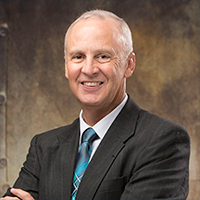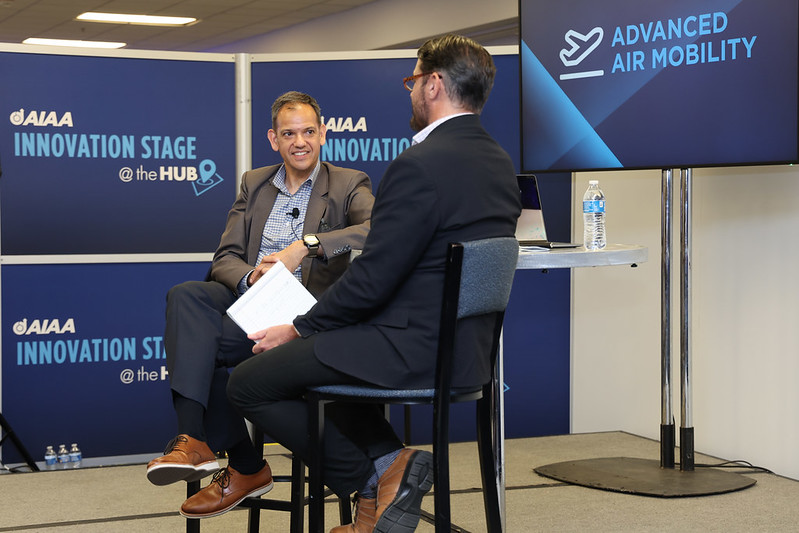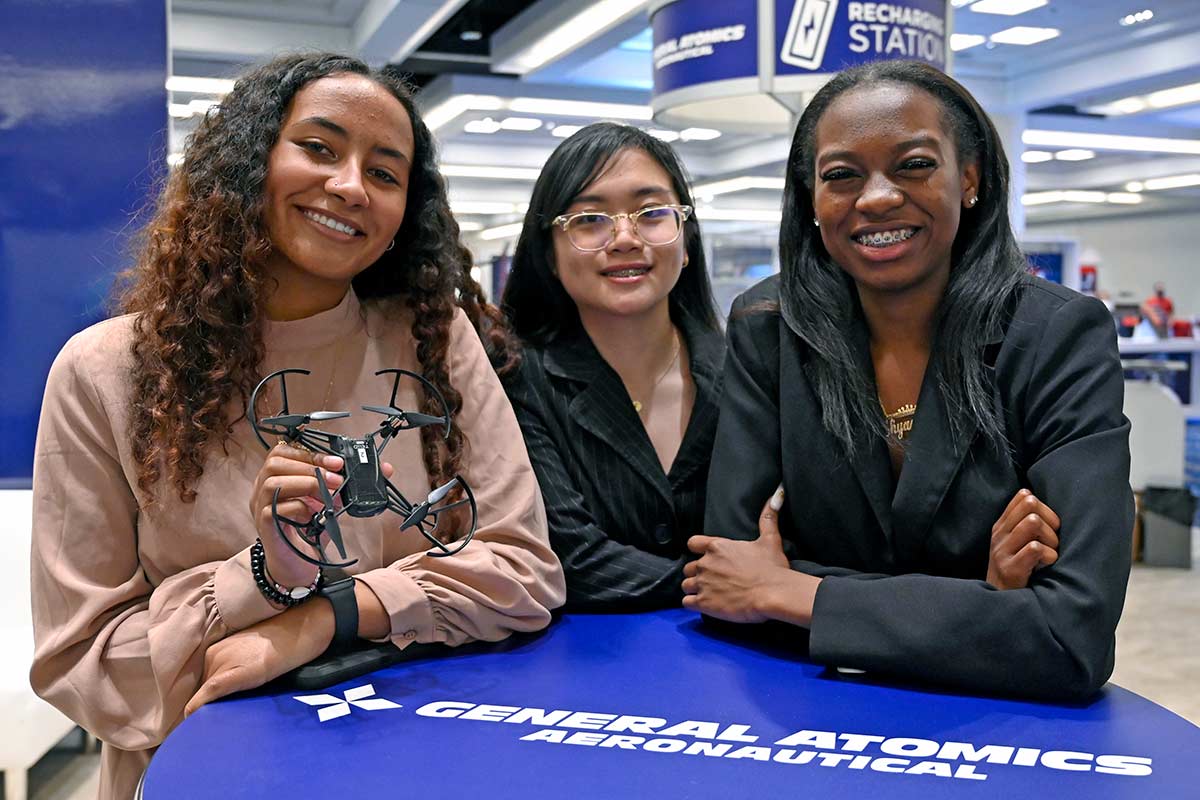the HUB
The HUB, sponsored by General Atomics Aeronautical Systems, is the heart of networking at the 2023 AIAA AVIATION Forum in San Diego. Sessions throughout the week include special panels, sponsor presentations, and fun activities.
Sponsor of the HUB
the HUB Schedule*
*Schedule is subject to change.
All times are listed in Central Time (PDT). All HUB sessions will take place at the HUB in Seaport Ballroom.
-
SUAS/ALE Aerial Recovery
Description
SUAS/ALEs have become valuable military assets but have limitations on their endurance and range. Further, most currently are recovered via belly or skid landing, which is not possible for operations over blue water. Even when recovering on land, the ALE’s airframes and payloads are jeopardized. To remain affordable, they must utilize inexpensive sensors with limited performance. ALE Aerial Recovery will be a game changer: ALEs can be recovered over blue water and no longer will airframes and payloads be jeopardized. ALEs will be able to carry high performance sensors that will dramatically improve the ALE’s effectiveness. This presentation will show GA-ASI’s concept for SUAS/ALE aerial recovery, the mission cost benefit of SUAS/ALE aerial recovery, and our technical roadmap.Sponsored by:

Speakers
-
 Mike Allwein
Technical Director
Mike Allwein
Technical Director
-
-
A HiL Framework for Real-Time Turbine Engine Simulations (RTES)
Description
An illustrative discussion of the Hardware-in-the-Loop framework designed for turbine engine simulations based on commonly known industry requirements. The framework allows formal system level verification testing of gas turbine engine control systems, supports multiple engine applications, and can simulate multi-engine configurations using deterministic real-time solutions.Sponsored by:

Speakers
-
 Anish Anthony
VP, Product Management
Anish Anthony
VP, Product Management -
 Dixit Bhatta
Applications Engineer
Dixit Bhatta
Applications Engineer -
 Bob Hartley
Sr. Consulting Engineer
Bob Hartley
Sr. Consulting Engineer
-
-
Whisper Jet Revealed
Description
What if ... you had a new propulsion technology that even at small thrust class could achieve an efficiency of >90%? And what if you realized that for the same total amount of power required, using 22 small electric motors is 4.7x lighter than using 1 big electric motor? And what if you realized that by using many small electric motors, the cube-square law made thermal cooling become a simple passive solution, instead of requiring complex active liquid cooling systems to remove the low grade heat of one big electric motor? How would you design an aircraft to leverage such radical changes to how propulsion systems scale? How would aircraft capabilities change as propulsion, aerodynamics, and acoustics were all combined into a single unified highly integrated solution? Come see the future unveiled as Whisper Aero reveals the Whisper Jet. Join us at Booth 118Sponsored by:

Speakers
-
 Mark Moore
CEO
Mark Moore
CEO
-
-
Aztec Aerospace Design: The SDSU Design/Build/Fly Team and the Journey to Tucson
Description
Hear about SDSU's journey to 2023 Design/Build/Fly and the aircraft they designed and flew at the competition.
-
AIAA AVIATION Forum Veteran and Military Meet and Greet
Description
Are you currently serving in the military or a veteran? Connect with your fellow service members at the AIAA AVIATION Forum Welcome Happy Hour. Look for the specially designated area for Veterans and Military in the HUB. Everyone is warmly invited!Sponsored by:
-
PEGASAS Center of Excellence for General Aviation
Description
The Partnership to Enhance General Aviation Safety, Accessibility and Sustainability (PEGASAS) is an FAA Center of Excellence for General Aviation. The mission of PEGASAS is to enhance general aviation safety, accessibility, and sustainability by partnering the FAA with a national network of world-class researchers, educators, and industry leaders. This discussion will focus on how the PEGASAS Center of Excellence for General Aviation can answer research questions for advanced air mobility.Speakers
-
 William Crossley
J. William Uhrig and Anastasia Vournas Head of Aeronautics and Astronautics, Purdue University; Director, FAA Center for General Aviation Research (PEGASAS)
William Crossley
J. William Uhrig and Anastasia Vournas Head of Aeronautics and Astronautics, Purdue University; Director, FAA Center for General Aviation Research (PEGASAS) -
 Keith Hoffler
President, Senior Research & Development Engineer, Adaptive Aerospace Group; Advisory Board Member, FAA Center for General Aviation Research (PEGASAS)
Keith Hoffler
President, Senior Research & Development Engineer, Adaptive Aerospace Group; Advisory Board Member, FAA Center for General Aviation Research (PEGASAS) -
 John Valasek
Aerospace Engineering, Texas A&M University; Site Director, FAA Center for General Aviation Research (PEGASAS)
John Valasek
Aerospace Engineering, Texas A&M University; Site Director, FAA Center for General Aviation Research (PEGASAS)
-
-
Machine Learning at the Edge: UAV Automatic Takeoff and Landing
Description
Artificial intelligence (AI) and machine learning (ML) are an increasing area of emphasis for the Department of Defense (DoD). In its 2022 budget the Pentagon requested $4.3 billion for AI/ML-related efforts, an over 50% jump in a two-year span. Unfortunately, much of the driving technology is being developed for commercial applications due to the relatively small size and challenges associated with the defense market. Common commercial assumptions like ample compute power, internet connectivity, and stable power are not valid in DoD applications due to deployment in what is referred to as the edge on low size, weight, and power (SWaP) platforms. Edge AI/ML refers to processing data and running algorithms on the deployed device rather than centrally. This concept allows AI/ML to run without connectivity, an important feature for military platforms that can experience degraded communication. In addition, DoD edge computing often happens in low SWaP environments due to mission and cost requirements. This can be challenging for commercially developed technology that often is designed to live in large data centers with access to ample compute resources. As a result, to make AI/ML technology deployable and tactically relevant, edge computing and low SWaP deployment problems need to be addressed. This presentation describes the process of deploying AI/ML models in low SWaP environments at the edge. Specifically, the talk looks at developing a vision-based automatic takeoff and landing deep learning system for a UAV. The presentation details the model development and optimization process for low SWaP deployment. In addition, it covers testing of the model using different deployment optimization strategies and the trade-offs associated with each. Ultimately, the presentation provides the community with an example of how to address a pressing problem associated with deploying AI/ML for military applications.Sponsored by:

Speakers
-
 Anastacia MacAllister
Technical Director, Autonomy & Artificial Intelligence
Anastacia MacAllister
Technical Director, Autonomy & Artificial Intelligence
-
-
EATS Presentation
Speakers
-
 Marty Bradley
Sustainable Aviation Consultant and Educator
Marty Bradley
Sustainable Aviation Consultant and Educator -
 Herb Schlickenmaier
President
Herb Schlickenmaier
President
-
-
International Powered Lift Conference Session
Speakers
-
 Geoffrey J. Jeram
U.S. Army Combat Capabilities Development Command Aviation & Missile Center
Geoffrey J. Jeram
U.S. Army Combat Capabilities Development Command Aviation & Missile Center
-
-
Leveraging Common Components in Finite Element Assembly Models
Description
Aircraft manufacturers have long learned to take advantage of common components within design variants. For example, a typical airplane would have several design variants sharing the same wing, empennage and cockpit while having different lengths of fuselage. Significant cost savings can be achieved by reusing common components in aircraft and spacecraft assemblies. The finite element analysis world, however, has not been able to fully leverage common components in assembly models. Components are typically organized as “include files” in an assembly model. But due to the strict requirement of unique FE entity IDs, these common component models cannot be easily reused. In order to be reused, a component model typically needs to be renumbered, repositioned, or reoriented. This process is not only time-consuming, but also prone to error. In addition, a component model may appear in many design variants with thousands of load cases. It is not a trivial task to envelope and max/min search the loads associated with a component. Careful and tedious bookkeeping is required to keep track of which design variant and what loading event generated the critical component design loads. This presentation will introduce an efficient assembly modelling method – the MSC Nastran Modules. This method eliminates the need for unique FE entity ID numbering, automates component connections, allows easy instancing (translate, mirror, and rotate) of components and generates modular results to streamline the enveloping and max/min search of loads. Real-world examples of a UVA drone, offshore wind turbine platform, and a truck frame assembly will be used to demonstrate the workflow and benefits of Modules.Sponsored by:

Speakers
-
 Hanson Chang
Senior Lead Application Engineer, Manufacturing Intelligence Division
Hanson Chang
Senior Lead Application Engineer, Manufacturing Intelligence Division
-
-
NASA Sustainable Flight National Partnership Project Managers Panel
Description
The NASA Sustainable Flight National Partnership (SFNP) mission is to accelerate toward net-zero carbon emissions for our next-generation subsonic transports by 2050. Project managers supporting the SFNP mission will introduce their projects and provide insight as to how they became a NASA project manager, including sharing some of their technical and leadership challenges and opportunities.Moderator
-
 Martiqua L. Post
SFNP Technical and Partnership Advisor
Martiqua L. Post
SFNP Technical and Partnership Advisor
Panelists
-
 Gaudy Bezos-O’Connor
Project Manager, Electrified Powertrain Flight Demonstration, Integrated Aviation Systems Program
Gaudy Bezos-O’Connor
Project Manager, Electrified Powertrain Flight Demonstration, Integrated Aviation Systems Program -
 Brent Cobleigh
Project Manager, Sustainable Flight Demonstrator Project
Brent Cobleigh
Project Manager, Sustainable Flight Demonstrator Project -
 Shivanjli Sharma
Air Traffic Management eXploration (ATM-X) Deputy Project Manager
Shivanjli Sharma
Air Traffic Management eXploration (ATM-X) Deputy Project Manager -
 Dale Van Zante
Project Manager, Advanced Air Transport Technology
Dale Van Zante
Project Manager, Advanced Air Transport Technology
-
-
Reaching new Heights in Aerospace with Cloud-Based Engineering and CAE Simulations
Description
Experts from Rescale invite you to join us to uncover the transformative power of cloud-based engineering in Aerospace! Learn how industry leaders like Boom Supersonic and Vertical Aerospace are optimizing design and performance through multi-disciplinary optimization and surrogate models. Discover the cutting-edge cloud hardware technology teams are using to analyze applications like wing structural strength, turbine flow, antenna placement, and lightning strikes, and more. And, see how to run simulations faster in the cloud using Helios, Star-CCM+, and OpenFOAM to drive new breakthroughs.Sponsored by:

Speakers
-
Consensus and Collaboration: Empowering Volunteer Leaders
Description
Discover examples and scenarios that can boost your impact on the aerospace community.Speakers
-
 Peter Montgomery
Chair, AIAA Talent and Leadership Development Committee; Director of Commercialization, Test & Operations Support Contract, Kennedy Space Center, Jacobs
Peter Montgomery
Chair, AIAA Talent and Leadership Development Committee; Director of Commercialization, Test & Operations Support Contract, Kennedy Space Center, Jacobs
-
-
Paper Airplane Contest
Description
Test your design and flight operations skills against the brightest minds in aviation. Fold and fly your own paper airplane versus experts and enthusiasts. Fly for fun! Earn bragging rights! Compete for prizes!
-
Sustainability Leadership: Addressing Industry Developments in Aviation
Description
Leaders from Airbus, Boeing, and GE Aviation continue their discussion begun at the 2022 AIAA AVIATION Forum around driving change in the aviation industry around sustainability.Speakers
-
 Jerrold Cline
Senior Research Scientist
Jerrold Cline
Senior Research Scientist -
 Ellen Ebner
Director, Sustainable Technologies, Sustainability & Future Mobility
Ellen Ebner
Director, Sustainable Technologies, Sustainability & Future Mobility -
 Amanda Simpson
Vice President, Research and Technology
Amanda Simpson
Vice President, Research and Technology
-
-
Obstacle Detection as the Enabling Technology for Urban Air Mobility
Description
Flight safety has always been an issue in aviation, and will be one of the most sensitive aspects in urban air mobility. Safety will be one of the first hurdles to be overcome to get the new mobility off the ground, because flight safety — especially in UAM — means passenger safety and safety for those living in the cities that will be crossed by eVTOLs.Speakers
-
 Fabio Masci
Founder and CEO
Fabio Masci
Founder and CEO
-
-
GA-ASI Automatic Takeoff and Landing Systems: Past, Present, and Future
Description
For over 20 years, General Atomics-Aeronautical Systems Inc. (GA-ASI) has been developing and refining the Automatic Takeoff and Landing Capability (ATLC) used across its fleet of UAVs. Originally demonstrated in 2002, ATLC has since been integrated into nearly all the 27+ aircraft variants that GA-ASI produces. Today, this system is used in broad applications to reduce pilot workload, improve safety of operations, enable operations in inclement weather, and more. This presentation will review the history of ATLC, introduce the fundamental design components of the system, and share a few highlights of what’s in store for ATLC in the future.Sponsored by:

Speakers
-
 Alexander Valencourt
Flight Controls Engineering Supervisor
Alexander Valencourt
Flight Controls Engineering Supervisor
-
-
Transforming Logistics with Elroy Air’s Chaparral UAS
Description
Learn about the future of aerial logistics with Elroy Air as they work to bring same-day shipping to every person on the planet. Their revolutionary Chaparral hybrid-electric VTOL UAS combines air and ground autonomy, enabling automated terminal navigation and cargo loading for rapid turnaround times with minimal human touch. With a cargo capacity of 300–500 lbs and mission range up to 300 miles, Elroy Air’s system will revolutionize commercial middle-mile logistics, humanitarian shipping, and military resupply. Join Elroy Air’s CEO Dave Merrill to hear about the transformative potential of the Chaparral UAS and explore the impacts of next-generation automated logistics.Sponsored by:

Speakers
-
 David Merrill
CEO and Co-Founder
David Merrill
CEO and Co-Founder
-











